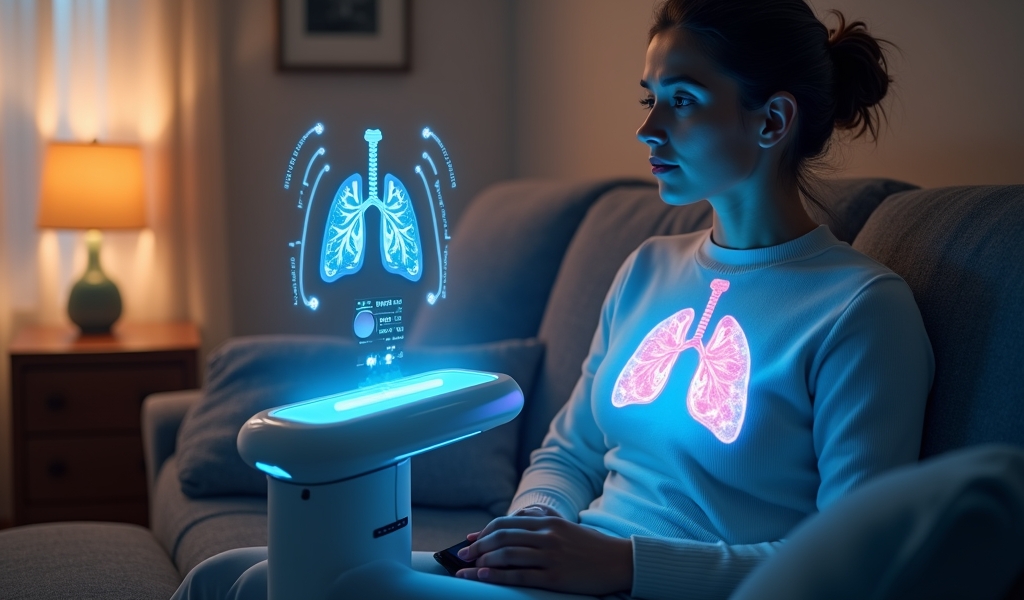Overview
Online pneumonia screening tools leverage technologies such as symptom assessment, audio analysis, and pulse oximetry to provide accessible early detection of pneumonia with 80-85% accuracy compared to hospital-based diagnoses. These tools serve as valuable triage instruments that complement traditional medical care by making respiratory assessment more accessible, potentially saving lives through earlier intervention while optimizing healthcare resources, though they cannot replace comprehensive clinical evaluation and should not be used in emergency situations requiring immediate medical attention.
Table of Contents
- Introduction
- The Need for Accessible Pneumonia Detection
- How Online Pneumonia Screening Works
- Accuracy and Reliability
- Benefits of At-Home Pneumonia Screening
- Popular Online Pneumonia Screening Tools
- When to Use Online Screening vs. Seek Emergency Care
- Future of At-Home Respiratory Disease Detection
- Conclusion
- Frequently Asked Questions
Introduction
Pneumonia remains one of the most common yet serious respiratory infections worldwide, characterized by inflammation of the air sacs in one or both lungs. According to the World Health Organization, pneumonia claims the lives of approximately 2.5 million people annually, with children under five and adults over 65 being particularly vulnerable.
Despite its prevalence and severity, pneumonia diagnosis traditionally requires in-person clinical assessment, chest X-rays, and laboratory tests—resources not readily available to everyone. The COVID-19 pandemic accelerated the development and adoption of remote healthcare solutions, and now, online pneumonia screening tools offer promising alternatives for early detection from the comfort of home.
This article explains how these emerging technologies work, their reliability, and how they fit into comprehensive respiratory care—information that could potentially save lives through earlier intervention. Online pneumonia screening represents a significant advancement in telehealth, making critical diagnostic capabilities more accessible than ever before.
The Need for Accessible Pneumonia Detection
Traditional pneumonia diagnosis faces several challenges. Many patients delay seeking care due to transportation difficulties, inability to take time off work, prohibitive healthcare costs, or limited access to specialists in rural areas. For immunocompromised individuals, even visiting a medical facility poses infection risks.
These barriers to timely diagnosis can significantly impact outcomes. Pneumonia progresses rapidly, and delayed treatment increases the risk of complications, hospitalization, and mortality. Seniors living independently, individuals in underserved communities, and those with chronic respiratory conditions stand to benefit most from accessible screening options.
Dr. Miranda Chen, Chief Medical Officer at Dr. Telx, explains: “For many of our patients, particularly those in rural areas or with mobility challenges, the ability to perform initial respiratory assessments at home can mean the difference between early intervention and a medical emergency.”
Furthermore, the seasonal nature of respiratory infections often creates surges that overwhelm healthcare systems. Online pneumonia screening can help alleviate this burden by identifying which cases require immediate attention and which can be safely monitored remotely with telehealth doctors providing guidance.

How Online Pneumonia Screening Works
Online pneumonia screening leverages several technologies to assess respiratory health:
1. Symptom Assessment Tools: Digital questionnaires evaluate clinical indicators like fever, cough characteristics, chest pain, and breathing difficulties.
2. Audio Analysis: Some platforms use smartphone microphones to record breathing and coughing patterns. Advanced algorithms analyze these sounds for abnormalities indicating fluid or inflammation in the lungs.
3. Pulse Oximetry Integration: Many screening tools sync with pulse oximeters that clip onto a fingertip to measure blood oxygen levels—a critical indicator of respiratory function.
4. Thermal Imaging: Newer smartphone attachments can detect temperature variations across the chest, potentially identifying inflammatory responses.
The typical screening process involves downloading an application, creating a user profile with relevant medical history, responding to targeted questions about symptoms, and potentially recording breathing sounds or inputting pulse oximeter readings. Within minutes, AI-powered algorithms analyze this data against vast databases of confirmed pneumonia cases to generate risk assessments.
After completion, users receive a risk categorization (low, moderate, or high) along with recommended next steps. Many platforms integrate with telehealth services, enabling immediate consultation with healthcare providers for concerning results through an online doctor visit if necessary.
Accuracy and Reliability
Current online pneumonia screening tools demonstrate promising accuracy rates, with some clinical studies showing 80-85% correlation with hospital-based diagnoses. However, this still falls short of the gold standard of clinical evaluation combined with imaging and laboratory confirmation.
These technologies excel at identifying clear-cut cases with typical presentation but may miss atypical pneumonia or cases complicated by underlying conditions. Environmental factors like background noise can also impact audio analysis accuracy.
Dr. Telx respiratory specialist Dr. James Nguyen emphasizes: “Online screening tools serve as valuable triage instruments, but they complement rather than replace comprehensive medical evaluation. They’re most effective when integrated into a broader care plan supervised by healthcare providers.”
Users should understand that these tools provide risk assessments rather than definitive diagnoses. A negative result doesn’t guarantee absence of pneumonia, and positive screenings always warrant professional follow-up.
Ongoing improvements in machine learning algorithms continue to enhance accuracy. As more data is collected from diverse patient populations, these systems become increasingly adept at recognizing subtle presentation differences across age groups, genetic backgrounds, and comorbidity profiles.
Benefits of At-Home Pneumonia Screening
The advantages of online pneumonia screening extend beyond convenience:
Early Detection: Identifying potential pneumonia days earlier can significantly improve treatment outcomes. The difference between catching pneumonia in its early stages versus waiting until symptoms become severe can be the difference between outpatient treatment and hospitalization.
Healthcare Resource Optimization: Preliminary screening helps direct high-risk patients to appropriate care while preventing unnecessary emergency room visits for milder cases. This strategic allocation of medical resources benefits the entire healthcare ecosystem.
Continuous Monitoring: For patients recovering from pneumonia, these tools enable tracking recovery progress between appointments. This ongoing assessment helps detect relapses or complications promptly.
Reduced Healthcare Costs: Early intervention typically requires less intensive treatment, translating to cost savings for both patients and healthcare systems. A Health Affairs study found that early detection and treatment of pneumonia could reduce hospitalization costs by up to 40%.
Accessibility: Screening becomes available to populations previously underserved by traditional healthcare infrastructure. This democratization of healthcare technology helps address longstanding disparities in access to quality care.

Popular Online Pneumonia Screening Tools
The market now offers several pneumonia screening options, each with unique features:
RespiScan provides comprehensive respiratory assessment with audio analysis and symptom tracking, offering free basic screenings and subscription-based monitoring services. Their platform distinguishes between different types of respiratory sounds with remarkable precision.
PneumaCheck integrates with common wearable devices and has specialized algorithms for different age groups, though it requires a one-time purchase. Their pediatric module is particularly noteworthy for its child-friendly interface and age-specific reference ranges.
LungHealth AI features telehealth integration for immediate connection to clinicians following concerning results, operating on a per-use fee structure. Their platform emphasizes accessibility, with multilingual support and options for users with visual or hearing impairments.
Most users report appreciation for the peace of mind these tools provide, though some note the learning curve associated with proper use of audio recording features. Patient testimonials frequently mention how these screenings helped them decide when a virtual doctor visit was necessary versus when self-care was sufficient.
When selecting a screening tool, consider factors like cost structure, device compatibility, and whether the platform offers ongoing monitoring capabilities. Some insurance providers now offer coverage or discounts for approved screening tools, recognizing their potential to reduce overall healthcare expenditures.
When to Use Online Screening vs. Seek Emergency Care
Online pneumonia screening is appropriate for initial assessment of mild to moderate respiratory symptoms and monitoring known conditions. However, certain situations demand immediate medical attention regardless of screening results:
– Severe difficulty breathing or shortness of breath
– Blue discoloration of lips or face
– Chest pain that radiates to arms, jaw, or back
– Confusion or altered mental state
– High fever unresponsive to medication
– Coughing up blood
For children, additional emergency indicators include:
– Rapid breathing (more than 40 breaths per minute)
– Severe difficulty feeding
– Extreme irritability or lethargy
After receiving a high-risk assessment from an online screening tool, contact your healthcare provider within 24 hours. For moderate risk, schedule a telehealth appointment within 1-2 days while monitoring symptoms.
Remember that online pneumonia screening serves as a complement to—not a replacement for—professional medical judgment. The tools are most valuable when used as directed by healthcare providers as part of a comprehensive care strategy.
Future of At-Home Respiratory Disease Detection
The horizon for respiratory health technology looks promising. Researchers are developing attachable spirometry devices for smartphones to measure lung function more precisely. Multi-parameter AI models that simultaneously analyze voice patterns, breathing sounds, and reported symptoms show enhanced accuracy in clinical trials.
Integration with electronic health records will soon allow seamless transfer of screening results to healthcare providers, enabling more coordinated care approaches. Beyond pneumonia, these technologies are expanding to detect early signs of COPD exacerbations, asthma attacks, and other respiratory conditions.
Emerging research from the Nature Digital Medicine journal indicates that combining audio analysis with symptom questionnaires and pulse oximetry can approach 90% accuracy in pneumonia detection—nearly matching clinical assessments.
Additionally, machine learning systems are being trained to identify subtle patterns that differentiate bacterial from viral pneumonia, potentially guiding appropriate antibiotic use and combating antimicrobial resistance.
The future also holds promise for population-level applications. Anonymous, aggregated screening data could help public health officials identify respiratory disease outbreaks earlier, enabling faster community responses and resource allocation.
Conclusion
Online pneumonia screening represents a valuable addition to the healthcare landscape, empowering individuals to take proactive roles in monitoring respiratory health. While these tools cannot replace comprehensive medical evaluation, they provide an accessible first step toward early detection and intervention.
Used responsibly—with an understanding of their capabilities and limitations—at-home screening technologies can help bridge healthcare access gaps, potentially saving lives through earlier treatment of pneumonia. The democratization of diagnostic capabilities through online pneumonia screening marks a significant advancement in how we approach respiratory health management.
As these technologies continue to evolve, they will likely become increasingly integrated with traditional healthcare delivery models, creating a more connected and responsive system. The ultimate goal remains consistent: ensuring that everyone has access to timely respiratory assessment regardless of geographic, economic, or mobility constraints.
For those experiencing respiratory symptoms, consider using an online pneumonia screening tool as an initial step, but always follow up with healthcare providers for proper diagnosis and treatment plans. This balanced approach—leveraging technology while maintaining professional medical oversight—represents the future of effective respiratory care.
Frequently Asked Questions
How accurate are online pneumonia screening tools compared to in-person diagnosis?
Online pneumonia screening tools currently achieve 80-85% correlation with clinical diagnoses in optimal conditions. However, they cannot match the accuracy of comprehensive in-person assessments that include physical examination, laboratory tests, and imaging studies. These tools excel at identifying clear-cut cases but may miss atypical presentations or complicated cases. They’re best used for initial assessment and triage rather than definitive diagnosis.
Can online pneumonia screening detect the difference between COVID-19 and pneumonia?
Most current screening tools cannot definitively distinguish between COVID-19 and pneumonia, as symptoms often overlap. Some advanced platforms analyze symptom patterns and breathing sounds that may suggest one condition over another, but confirmation requires specific testing. Many platforms now incorporate COVID-19 probability assessments alongside pneumonia risk evaluations, recommending appropriate testing based on symptom presentation and risk factors.
Are online pneumonia screening tools covered by insurance?
Insurance coverage for online pneumonia screening varies widely. Some health insurance providers have begun covering these tools as preventive care or as part of chronic disease management programs, recognizing their potential to reduce costlier emergency care. Medicare and Medicaid coverage is expanding in some states but remains inconsistent. Check with your specific insurance provider about coverage options, as policies are evolving rapidly as these technologies demonstrate cost-effectiveness.
How often should I use online pneumonia screening if I have a chronic respiratory condition?
For those with chronic respiratory conditions like COPD, asthma, or bronchiectasis, many pulmonologists recommend regular screening during symptomatic periods or seasonal changes that typically trigger exacerbations. Weekly screening during respiratory infection seasons and immediate screening when experiencing worsening symptoms provides valuable data trends. However, always follow your healthcare provider’s specific recommendations, as optimal frequency depends on your particular condition, history, and risk factors.
What equipment do I need for the most accurate online pneumonia screening results?
For optimal accuracy, most comprehensive screening platforms recommend having a smartphone with a good-quality microphone for breathing sound analysis, a pulse oximeter for oxygen saturation measurements, and a reliable thermometer for temperature readings. Some advanced systems also work with Bluetooth-enabled stethoscopes that enhance sound capture quality. For consistent results, conduct screenings in quiet environments with minimal background noise and follow the platform’s specific instructions for microphone placement and breathing patterns.

